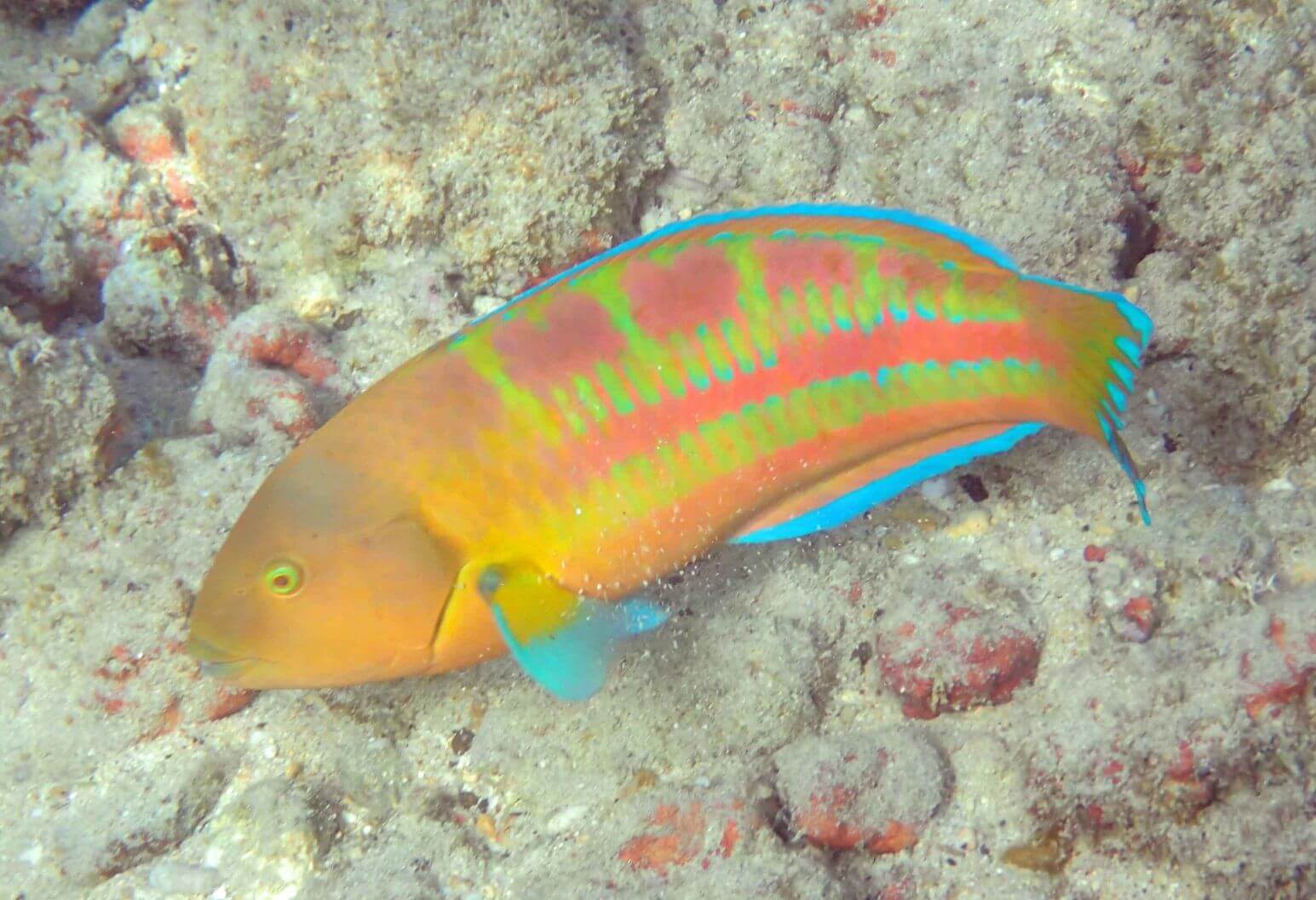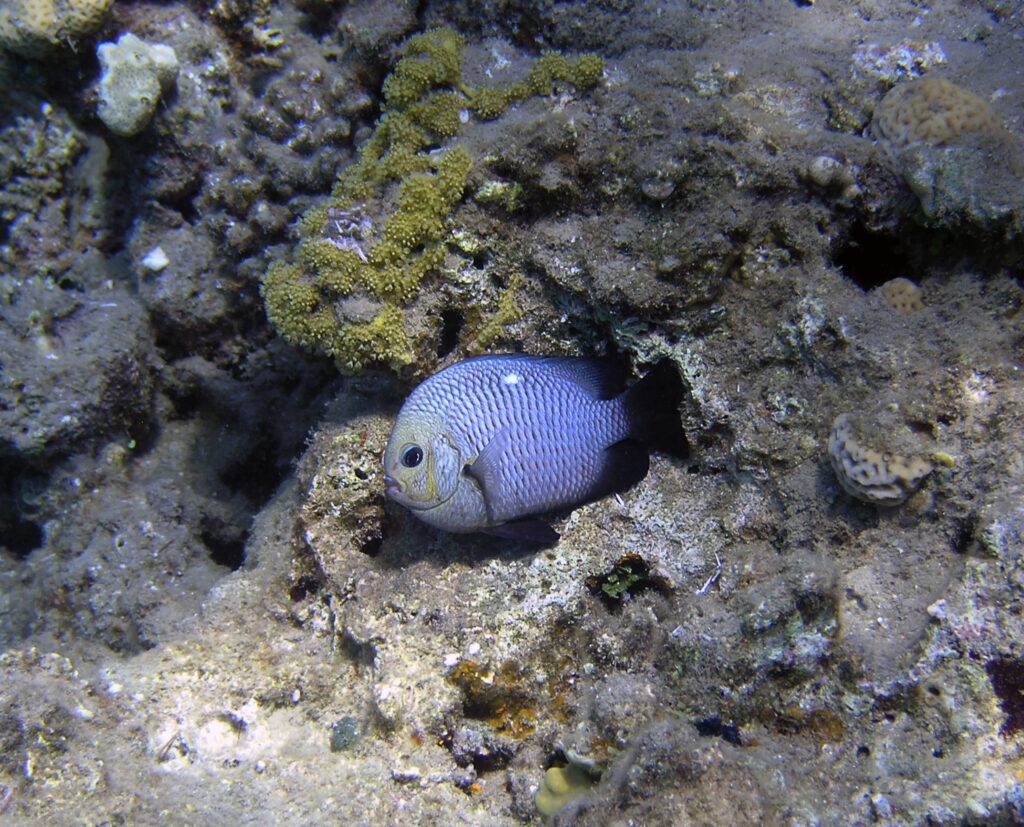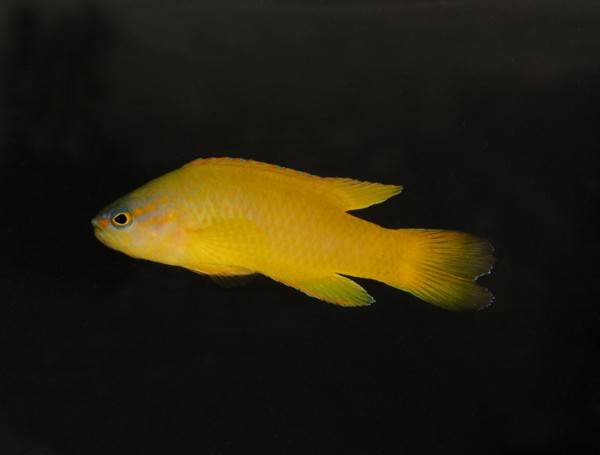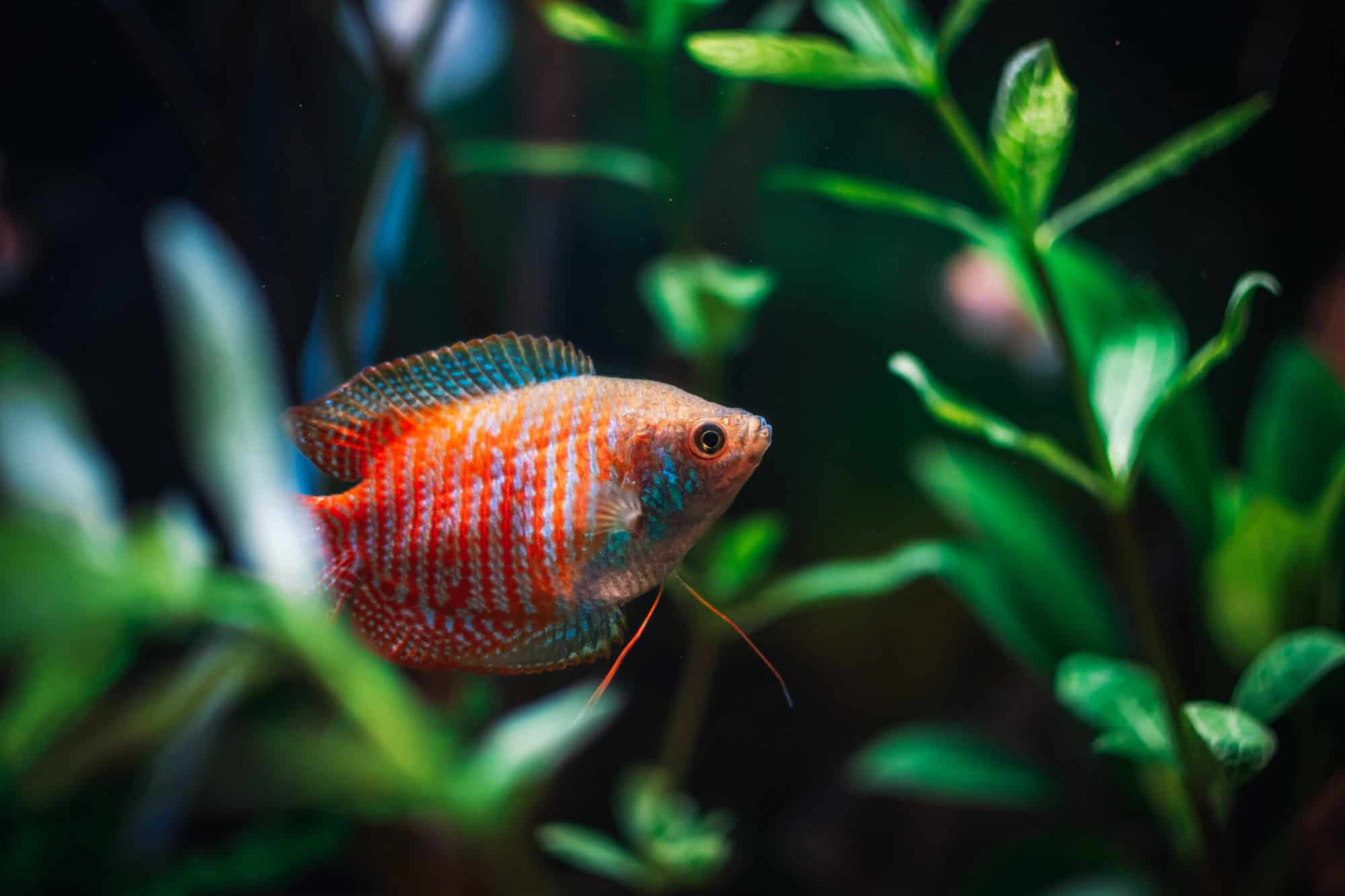Quick Facts
| Scientific Name: | Halichoeres claudia |
| Other Names: | Ornate Wrasse, Green-Barred Wrasse, Red-Lined Wrasse, Ladder Wrasse |
| Reef Safe: | Yes |
| Lifespan: | 5-8 years |
| Size: | 11 inches |
| Care: | Easy |
| Diet: | Carnivore; snails, worms, shrimp |
| Water Parameters: | 72-78F, 8.1-8.4pH, 8-12dKH, 1.020-1.025SG |
| Tank Size: | 250 gallons |
| Behavior: | Paceful |
| Breeding Difficulty: | High. Females can turn into males |
Are you looking for a special aquarium gift for the holidays? Then ask Santa for a Christmas Wrasse! This fish is not only good looking but it is also peaceful and easy to care for.
Can you imagine having a tiny moving christmas tree in your aquarium all year long? We do and we love it!
In this guide you will learn everything you need to keep your Christmas Tree.. sorry, Christmas Wrasse happy and healthy before, during and after the holidays. Let’s get started!
Species Summary
The Christmas Wrasse also known for its scientific name as Halichoeres claudia is a relatively low-maintenance, large-lipped stunner that lives in Indo-Pacific waters.
There’s some mystique regarding the Christmas Wrasse’s name.
While some enthusiasts claim that the fish is named after the Christmas feelings its red-and-green coloration inspires, others insist that the name comes from the fish’s origin near Christmas Island in the Indian Ocean.
The Christmas Wrasse is sometimes called the Ornate Wrasse, Green-Barred Wrasse, Red-Lined Wrasse, or Ladder Wrasse. It doesn’t take much imagination to realize that these nicknames are all owed to the distinct coloration and “barred” detailing of this species.
Appearance
Appearance is a pretty big topic with the Christmas Wrasse due to the fact that this fish’s aesthetic is responsible for everything from its name to its ongoing case of mistaken identity.
More on that last juicy tidbit in a moment! First, let’s talk about why the Christmas Wrasse is so interesting to look at!
Two fashion looks from the Christmas Wrasse:
- A slender, dirigible-shaped body that is famously covered in red horizontal lines that extend down to the dorsal, caudal, and anal fins.
- Green striations light this fish up like a Christmas tree!
While the coloration of this fish gets all the attention, color is far from the only thing that makes the Christmas Wrasse’s appearance interesting.
Author Note: The fish’s translucent pectoral fins help to keep its body floating along. A small mouth with large lips enables the Christmas Wrasse to feast on the small crustaceans that make up its carnivorous diet.
Let’s circle back to the Christmas Wrasse’s constant problem with mistaken identity. This fish is constantly mistaken for other similar species of fish that share some of its signature characteristics. In fact, many of the nicknames used for the Christmas Wrasse are actually names that are applied to this fish in error simply because it resembles other species with those names.
Is it a Surge Wrasse?
Christmas Wrasses are constantly mistaken for a similar fish called the Surge Wrasse (Thalassoma purpureum) due to a shared red-and-green color palette. However, there is a trick for telling these deep-sea doppelgangers apart.
A Surge Wrasse will have a “V” marking on the nose that is absent from the Christmas Wrasse. Christmas Wrasses also tend to be smaller than Surge Wrasses.
Lifespan
This fish is here for much more than just a season! The Christmas Wrasse can be expected to have a lifespan between five and eight years in captivity. Proper care and maintenance will be essential for helping your Christmas Wrasse to reach its lifespan potential.
Average Size
A fully mature adult Christmas Wrasse can be expected to reach an average size of 11 inches in length. While it’s not uncommon for them to hit 12 inches, this would be considered a very large fish for the species.
If you have a Christmas Wrasse that grows very large, there’s a chance that you were actually sold a Surge Wrasse that was improperly marketed as a Christmas Wrasse.
Christmas Wrasse Care
What does it take to make life jolly for your Christmas Wrasse? Like all tropical fish, the Christmas Wrasse has some pretty specific needs. This rundown for creating the perfect Christmas Wrasse tank can help you get started.
Tank Size
The best present you can give a Christmas Wrasse is a roomy aquarium that’s around 250 gallons in size. These fish need room to hide and explore. Make sure that you’re purchasing a tank with a lid to prevent these notorious jumpers from getting over the edge of the tank.
What to Put in Their Tank
Christmas Wrasses don’t need fancy tinsel or bulbs to feel right at home! Their tanks should instead be decorated with simple substrate that contains a decent amount of live rock.
This rock is important for satisfying the Christmas Wrasse’s hiding instinct. However, packing in too many rocks can make it difficult for this fish to enjoy the open space it needs for swimming.
Author Note: A nice sand bed that’s stacked about 1 inch high with granules will provide a perfect “safe zone” for your Christmas Wrasse to feel comfortable. One thing to know about this species is that it will burrow to sleep and hide.
Water Parameters
- Water temperature: 72° and 78°F
- pH levels: 8.1 to 8.4
- Water hardness: 8 to 12 dKH
- Specific gravity: 1.020 to 1.025
Are Christmas Wrasse Reef Safe?
Yes, the Christmas Wrasse is considered a reef-safe fish. In fact, they are staples of large-reef aquariums around the world! You can be assured that your Christmas Wrasse will leave your clams and coral alone.
That doesn’t mean that tank owners have a free pass to add the Christmas Wrasse to any reef environment. The small caveat with the Christmas Wrasse is that this fish will sometimes go after shrimp tank mates.
Author Note: One little-known benefit of adding Christmas Wrasses to tanks is that they are notorious for eliminating rapidly producing pyramid snails and flatworms that are commonly carried in by infected tank mates.

Common Possible Diseases & Prevention
The good news is that Christmas Wrasses aren’t especially susceptible to any devastating illnesses like marine velvet and ich. However, they are still vulnerable to common bacterial, parasitic, and fungal infections.
The best way to protect your fish from illness is to quarantine any new fish before introducing them to the tank. Similarly, isolate your Christmas Wrasse if it’s showing signs of illness. A veterinarian may be able to prescribe medications or antibiotics.
Author Note: You’ll know that you have a sick Christmas Wrasse on your hands if you see your fish hiding under substrate for a long period of time even though there is no noticeable threat.
Sick Christmas Wrasses will sometimes scrape their bodies against rocks in the aquarium. Due to the fact that Christmas Wrasses spend so much time diving under the substrate in general, they are slightly vulnerable to injuries caused by substrate.
Isolate a wounded fish to give it time to heal without the threat of predators.
What Do Christmas Wrasses Eat?
The Christmas Wrasse is a carnivore. As shared above, Christmas Wrasses love eating snails and worms that would otherwise devastate your tank in a short period of time.
The Christmas Wrasse devours these undesirables after uncovering them while poking around under rocks and substrate. Of course, you cannot expect a Christmas Wrasse to simply rely on this self-serve method of dining.
This fish’s appetite can be satisfied by the following owner-provided snacks:
Author Note: A quick glance at the narrow body of the Christmas Wrasse reveals just how short the digestive tract of this fish can be! With its tiny stomach, the Christmas Wrasse is forced to live in a constant state of voraciousness.
In order to keep up with the lightning-fast metabolism of the Christmas Wrasse, a tank owner should provide food four times per day.
Keeping a well-fed Christmas Wrasse isn’t just about keeping your pet happy. If your Christmas Wrasse is forced to work out its hunger creatively, other creatures in your tank could be jeopardy. Ornamental shrimp are especially vulnerable to hungry Christmas Wrasses.
Behavior & Temperament
The Christmas Wrasse is an easygoing, peaceful fish when it’s not forced to be concerned about finding a food source. You can expect your fish to spend its day pulling food and debris from rocks with its teeth.
It’s also quite a treat to watch your Christmas Wrasse “tucking itself in” every night as it works its way into the bedding of the tank.
Christmas Wrasse Tank Mates & Predators
Christmas Wrasses can generally cohabitate with other peaceful fish with very little drama. This fish will even do great with companions of the same species. Some highly compatible tank mates for the Christmas Wrasse include:
While Christmas Wrasses generally stay in the “Christmas spirit” with tank mates, they do have a habit of turning into bullies when paired with a small and specific handful of other fish.
The common factor is that these fish are smaller. Ones to avoid with your Christmas Wrasse include Firefish, Fairy Wrasses, and Flasher Wrasses.
Breeding
It’s difficult to tell male and female Christmas Wrasses apart. Generally, males are brighter than females. When breeding this fish, the only way to be successful appears to be to keep a harem of females with a single male.
If a male meets an untimely demise, one of the females from the harem will actually turn into a male in order to take over. So if you had two christmas wrasses and were planning on breeding them, now you are out of luck with two males.
Author Note: Christmas Wrasses are daytime spawners. They will usually signal that they’re ready to breed by deepening their coloration. The male will initiate breeding by swimming back and forth in a pacing motion while energetically waving his fins.
Of course, it’s important to be clear about the fact that breeding Christmas Wrasses in a home aquarium is rarely done due to the complexity of getting these fish to bond.
In Conclusion
Did you like learning about the Christmas Wrasse as much as we liked writing about it? This is an amazingly colorful fish with a great peaceful personality and low maintenance requirements.
It does not matter if you are reading this in the summer or right after the holidays, gifting yourself (or someone else) a Christmas Wrasse is a good idea all year long! Who wouldn’t want a moving Christmas tree in their aquarium?
If you enjoyed this guide then you will love our other Saltwater Care Guides where we try to cover as many fish as possible (as long as it fits in a home aquarium).
If we are missing a fish please feel free to reach out to us and don’t forget to tag us on Facebook when sharing cool Christmas photos!




